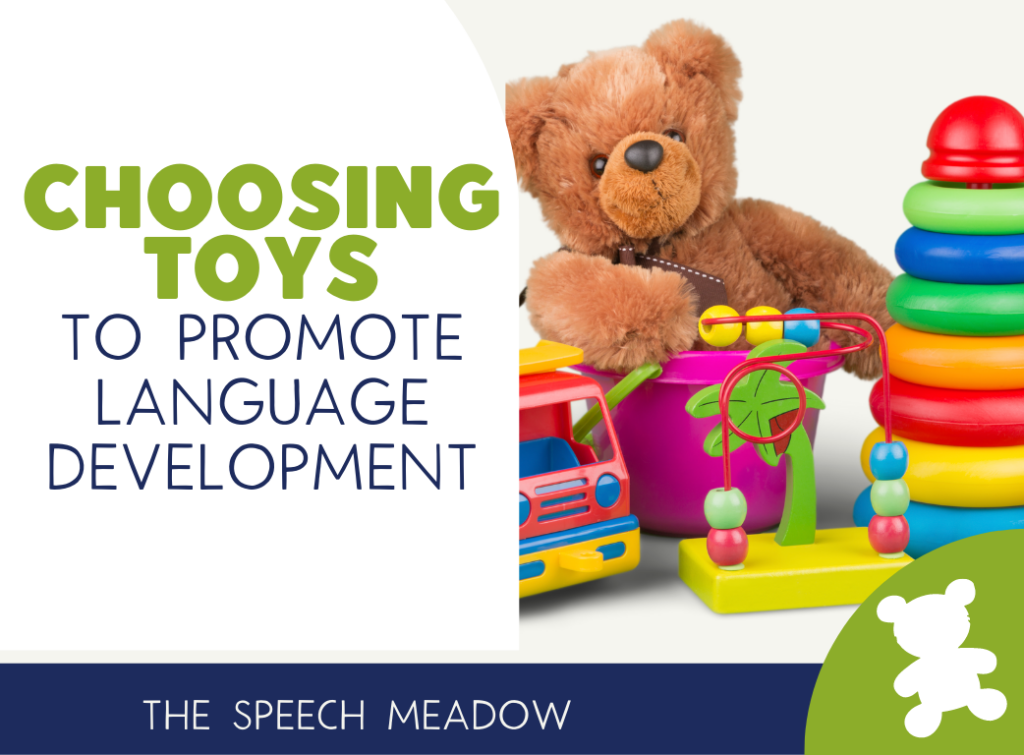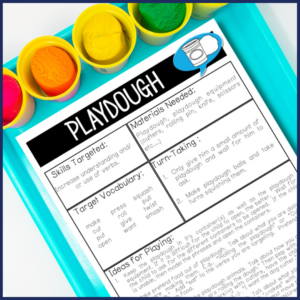You may be an SLP recommending that parents use play to help develop language skills, or maybe a parent been told to “play with your child.” Now what? It can be intimidating. Which toys? Is this going to expensive? Do I buy the “new shiny toy” that is marketed as a great educational toy? The answer is, the simpler the toys, the better. Here are three features for you to think about when choosing toys to promote language development.

1. Park the batteries.
Toys that have batteries can be engaging for kids because they may light up, move, or make noise. The big problem is they may light up, move, or make noise.
Researchers have found that if a toy makes noise, adults tend to talk less and let the toys do the “talking.” If you are letting the toys do the talking, then children have less opportunity to see how you form the sounds. There is less opportunity for you to change up the sounds the toys makes. Ever take a frog, and all of the sudden, you make mooing sounds? What do children do? Children familiar with the sounds that frogs make, will respond because they are not expecting mooing. This allows you to talk about how frogs don’t moo. This is a fun way to add language. As I alluded to the above, there are fewer opportunities for the child to use/develop their imagination. If you do have toys with batteries, take them out and play with them.
2. Pick toys that have a simple colour palate.
You might be thinking, a simple colour palate? Why? Toys that have different many different colours with different patterns look cool. It shouldn’t alter how adults and children interact with toys? Right? Wrong.
Well, researchers also looked at this, and it turns out that when given toys with lots of patterns and colours adults have difficulty naming the parts of the toy and as a result, talk less. Adults are then not consistent with what they call those different parts and use more generic vocabulary (e.g. “this” or “that”) or change up what they are calling the various pieces. This then reduces the opportunities to develop vocabulary. If you do have toys with lots of colours or patterns, pick a colour or pattern and consistently use that description when playing.
3. Pick toys that can be used in different ways.
When children are playing, they are not only developing language skills, but fine motor skills, gross motor skills, problem-solving skills, and their imagination. Children are also learning about the world. That is why children typically engage in play, such as cooking and playing with babies.
Toy food, animals, farms, cars, blocks, and Legos are great toys to use. This gives you opportunities to use a variety of language while playing. So if you have toy food, you can cook it, eat it, feed it to different toys. You can then talk about how the food tastes, what you are doing to prepare the food, what or who you are feeding etc. Toys that have a more narrow focus of how you use it limits the types of language you can use.
This is why many educational games are not ideal to use to develop language. Counterintuitive right? But educational toys tend to have a single focus. They also tend to focus on skills that may not be functional for the child at this time. How many children need to use the word “triangle ” in their everyday conversations? Very few. But naming triangles is essential later when learning math skills. Added to that, not all but many educational toys tend to be used by one person at a time. This can make it challenging to work on communication skills. You want to have the child engaged with you and focusing on back and forth interactions. Lastly, they can be costly, and children tend to use them for a short time, then get bored and look for other toys.
This is why many classic toys are considered classical. They are more open-ended, simple, and allow children to use and develop their fantastic imaginations. So when looking for toys, think back to toys that you liked to play with and introduce them to your children. These toys will help promote language development.
Looking for tips on how to play? Here is a blog post with tips to help encourage play, “Five Tips for Using Play to Encourage Language Development.”
or Click here for a handout of these top ten tips. If you would like more ideas on how to work on specific goals through play, check out Come Play! which has over 150 play ideas to help develop language.
What are some of your favourite toys?

